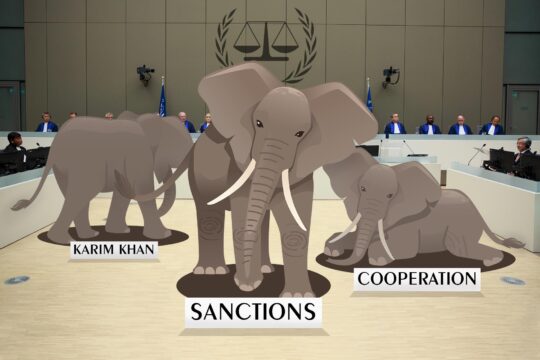Kamilindi was a journalist at Radio Rwanda from 1984 to 1994. He presented news in French for the radio. This witness is the 21st in the trial of three suspects accused of using the media to fuel the 1994 genocide in Rwanda. Unlike most other prosecution witnesses from Rwanda, he has chosen to testify without protection of his identity. Nahimana is co-accused with former politician and RTLM board member Jean-Bosco Barayagwiza and former "Kangura" newspaper editor Hassan Ngeze. All three have been charged with genocide and crimes against humanity. All three have pleaded not-guilty. Kamilindi said the offending press release had been broadcast at least four times on national radio, and that the massacres in Bugesera occurred directly afterwards. "Directly after the airing of this communiqué, there were widespread massacres in the Bugesera region, targeting members of the Tutsi ethnic group in particular," the witness told the court. He said Nahimana had ordered three times the broadcast of the communiqué. Kamilindi explained that the journalists had tried to oppose its broadcast for ethical reasons but that their editor, Jean-Baptiste Bamwanga, read it on air against their will. The statement, according to the witness, said that "the Inyenzi enemy is preparing to assassinate a certain number of Hutu leaders" and that the plan would be carried out by the internal wing of the "Inyenzi enemy", the Liberal party (PL). Kamilindi told the court that for the Hutu extremists, "Inyenzi" had come to mean not only the Tutsi rebel Rwandan Patriotic Front (RPF) but also all Tutsis and Hutu political opponents of the regime. He said the Radio Rwanda journalists had been told not to broadcast documents whose origin could not be authenticated, and that the press release fell into that category. The witness added that a code of ethics later adopted by Rwandan journalists warned them against gratuitous accusations, slander, insults and malicious insinuation, and recommended discretion and decency in their professional conduct. He said the spirit of this code of ethics had guided the Radio Rwanda journalists when they opposed broadcast of the communiqué. Kamilindi also said that he had listened "sporadically" to RTLM radio. He said he had even intended to buy two shares in this new, private radio, but that he had changed his mind after learning more about its promoters. "What put me off was that all those people came from the group of Hutu radicals, they all tended towards Hutu extremism," Kamilindi told the court. He said they included Nahimana, Barayagwiza, businessman Félicien Kabuga (still on the run) and Radio Rwanda's chief technician at the time Joseph Serugendo. The witness said that during the genocide, he took refuge in the Hôtel des Mille Collines in Kigali, where he undertook to inform the outside world about what was going on in the government zone. Kamilindi broke down and wept when he recounted how the former Rwandan army shelled the Hôtel des Mille Collines, following one of his reports on Radio France Internationale. He had told the court that his report on RFI met a reaction shortly afterwards from RTLM, whose presenter Valérie Bémériki warned him that "the Hôtel des Mille Collines is not a bunker". The witness said the hotel was then shelled, three hours after the RFI broadcast. AT/JC/FH (ME0521e)
Countries
- Afghanistan
- Algeria
- Angola
- Argentina
- Armenia
- Australia
- Austria
- Azerbaijan
- Bahrain
- Bangladesh
- Belarus
- Belgium
- Benin
- Bosnia & Herzegovina
- Brazil
- Burkina Faso
- Burundi
- Cambodia
- Cameroon
- Canada
- Central African Republic
- Chad
- Chile
- China
- Colombia
- Cote d’Ivoire
- Croatia
- Cyprus
- Dem. Rep. Of Congo
- Denmark
- Ecuador
- Egypt
- El Salvador
- Equatorial Guinea
- Eritrea
- Ethiopia
- Finland
- France
- Gabon
- Gambia
- Georgia
- Germany
- Ghana
- Greenland
- Guatemala
- Guinea
- Haiti
- Honduras
- Hungary
- Indonesia
- Iran
- Iraq
- Ireland
- Israel
- Italy
- Japan
- Jordan
- Kenya
- Kosovo
- Laos
- Lebanon
- Liberia
- Libya
- Lithuania
- Malaysia
- Maldives
- Mali
- Mauritania
- Mauritius
- Mexico
- Myanmar
- Namibia
- Nepal
- Netherlands
- New Zealand
- Nicaragua
- Niger
- Nigeria
- North Korea
- Norway
- Pakistan
- Palestine
- Peru
- Philippines
- Poland
- Republic of Congo
- Russia
- Rwanda
- Scotland
- Senegal
- Serbia
- Seychelles
- Sierra Leone
- Somaliland
- South Africa
- South Korea
- South Sudan
- Spain
- Sri Lanka
- Sudan
- Suriname
- Sweden
- Switzerland
- Syria
- Taiwan
- Tanzania
- Thailand
- Timor-Leste
- Togo
- Tunisia
- Turkey
- Uganda
- Ukraine
- United Arab Emirates
- United Kingdom
- United States
- Uruguay
- Vanuatu
- Venezuela
- Vietnam
- Yemen
- Zimbabwe



